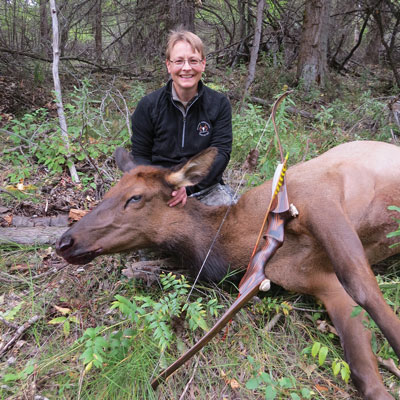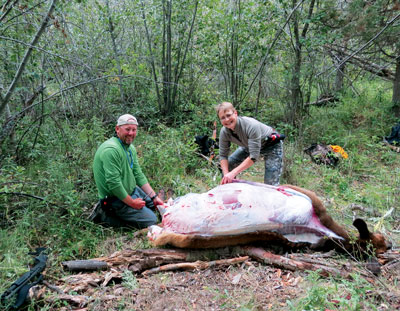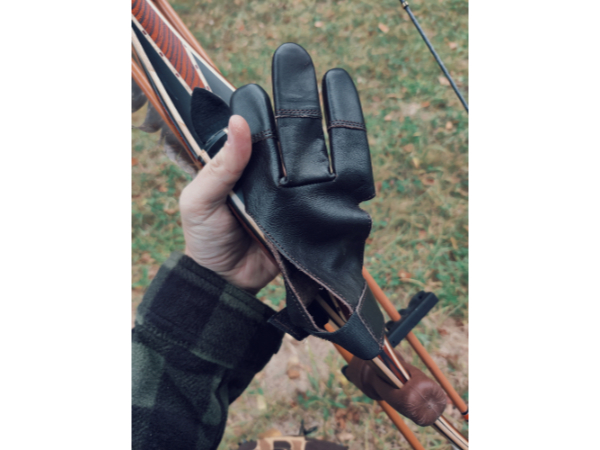All bowhunters know that success in the field is equal parts luck and skill. Over the years, I have been a bit short on the luck part, but have kept at it, confident that the “luck pendulum” would eventually have to swing my way. And so it was that I entered last year’s archery season fully motivated to put all my skill components in order so the luck factor could fall into place. I had my Schafer Silvertip in hand and many hours of practice from various elevations and angles. This preparation, along with perfectly tuned bamboo shafts, boosted my confidence and I felt more ready for the season than I had in a dozen years.
Tags A-Plenty
We are fortunate in Montana that we can draw or purchase multiple tags for mule and whitetail deer, and in some years for elk tags too. Such was the case with elk this year, as a “shoulder season” had been approved by the Commission, so hunters could hold both a general elk tag as well as an antlerless tag in certain districts. Since my luck has been especially sparse in the elk arena, I decided not to tempt fate by buying more than one tag. Besides, we much prefer venison at my house, so one tag would certainly be enough should I manage to stumble into an elk’s path.
Narrowing the Focus
I love chasing elk in early archery season for the simple joys of crisp September mornings, long climbs up mountains, and the beautiful light bending through aspen groves. However, this year I’d planned a two-week trip in November to Macchu Picchu and the Galapagos, so I’d be a bit short on hunting time. As much as I hated missing the elk rut, I decided I needed to narrow my focus in the early season to hunting deer to increase my chances for an early harvest. I accepted an invitation to hunt with some friends in an archery-only area where we could set up tree stands and hopefully harvest a few whitetails.
Sweet Setup
My friend, Scott Reed, helped me select a well-situated cottonwood tree which had braids of trails running in and out of the small meadow it bordered. Quite simply, it was a sweet site. Now we just had to strategize stand setup. Friends who have hunted with me in the past know that I have a love-hate relationship with tree stands. On the one hand, I have to acknowledge that a well-placed tree stand is one of the biggest factors in increasing one’s success. On the other, I really dislike heights, and it has taken me years of gradually increasing my comfort level with climbing into a tree. I am fortunate that Scott suffers my meticulous nature in setting my tree steps, hoisting my stand, seating it as securely as possible, and trimming any and all branches which might get in the way of my ascent and descent.
We set the stand at the “perfect” height, about ten feet up. I set the steps, Scott helped me hoist the stand, and I cut branches overhead to clear a path for my upper limb. The only downside was that a completely broadside shot on the main trail in front of me would also leave me completely without cover. I’d just have to hope my leafy-flage suit and the bushes below would provide enough visual interference so that I could draw on a deer.
Opening Possibilities
The opener occurred on Labor Day weekend, providing a three-day window of opportunity. The weather was just a bit warmer than we liked with temperatures forecast in the upper 60s, but at least it would be clear. We hoped the rifle hunters participating in the shoulder season on adjacent private land might mobilize the deer so they would wander into the public archery-only area. There were also elk sporadically travelling through the area, which some of our group intended to try tracking down for a shot.
I climbed into the stand on Saturday morning and, as my luck dictates, nothing came into the meadow. I opted for a different stand for Saturday night to keep my cottonwood stand fresh for the following morning. I had a couple of deer chase each other around within fifteen yards of the stand, but none offered a shot. I climbed out at dusk with another skunked hunt under my belt.
The next morning, I awoke feeling irritable that I hadn’t had so much as a shot opportunity yet. I chided myself in being so impatient this soon into the season, and I knew that it came from having had so many years pass without a bow kill. It was time to end the dry spell, and I just needed the opportunity to make things happen.
Quick Decisions
Once I got into the tree stand, I felt at ease and settled in to wait. About a half-hour after dawn, a doe tiptoed into the meadow behind me. Unfortunately, she put herself between me and every limb possible, so that opportunity slipped away. After another twenty minutes, a group of six whitetails splashed across the stream and opened up another opportunity. After entering the meadow, they milled around nervously and behaved as if they had me nailed, so I was again presented with only marginal shots which I had to pass on. “I just can’t catch a break,” I grumbled to myself.
Another thirty minutes passed, and I finally saw a fork-horn buck and a small group of elk 125 yards away. They all looked inclined to come my way. This was going to be interesting. Then I thought, “That little buck will probably mess this whole thing up.” I watched as the deer crossed through the back side of the meadow and meandered around to the back of my stand. He was pretty ratty looking, with a flea-bitten hide and not very much meat on his bones. I decided he wasn’t the best candidate for eating, and was relieved when he disappeared behind me into the thick brush without so much as a snort.
I then turned my attention to the elk. Three of them had decided to cross the stream—a cow, followed by her calf, followed by another cow. Good—now I could be sure which cow was the dry one. I started to talk myself through the scenario…they’re going to come up onto the bank about twenty yards away and broadside, which could be a shot, although it’ll have to be perfect. Indeed, the elk cleared the brush at twenty yards, appearing relatively calm. I began to turn, but they were eyeballing me and the shot just didn’t feel right, so I settled down and waited. They looked as if they meant to continue on a side trail and leave the meadow, but then seemed to think better of it. The lead cow turned and began heading right toward me on the trail, which would put them all broadside to me. I again began my mental dialogue…OK, get your bow arm in position, tighten your fingers on the string, make sure to get to full draw, don’t rush the shot, watch for any sign that they’re about to bolt, and if they get skittish, just let ‘em go.
The elk kept coming, with the lead cow and her calf glancing upward at me on their way past, but not showing any real uneasiness. OK, I passed the “lead cow” test. Now, here came the dry cow. I reminded myself that if she bolted, I should just let down rather than trying to rush a shot. The cow looked right up at me as she walked by broadside, and our eyes met. Now it was my turn to feel uneasy as she gazed up at me. I was at half-draw, and she continued by at the same speed. “It’s go time, Joelle,” I prodded myself, after one last reminder to myself that if she bolted, I needed to abort the shot. I was stunned that as I came to full draw, she stopped—just eight yards away, and at the perfect angle to place my arrow behind her shoulder.
I forced myself to look right at the spot I wanted to hit. I wanted a pass-through and knew that was harder out of a tree stand. I released, and the shaft sank almost to the fletch, with a solid “thunk.” The cow trotted off, following the lead cow and calf into the brush. The arrow didn’t pass through, but I saw a big spurt of blood so I knew I had a solid lung hit. As I listened, I heard the brush rustling and cracking, then silence, then more rustling and cracking, then silence. Thirty seconds later, I heard, “splash, splash, splash,” as the other elk crossed the stream. I liked what I heard, and hoped, as every bowhunter does, that the cow was dead the very minute she fell.
I waited forty-five minutes, and as I climbed out of my stand, I heard Scott and someone else across the stream. They had given me explicit instructions not to go looking for a downed animal or start packing one out by myself, since there were bears in the area. So, I packed up my gear and quickly waded across to recount the scenario to Scott and Erik. We needed to go back to camp to gather up game carts and other gear. Fortunately, the temperatures were in the low 50s, so we knew the meat would be all right—as long as the bears didn’t get to it first!

The author with her cow elk.
We returned fully outfitted with bear spray, a 12-gauge shotgun, and the rest of our gear. We crossed the stream and began throwing rocks, cracking limbs, and yelling, “Hey, bear, hey bear!” We got through the willows without incident, and I took them to the stand. I described the shot angle and the cow’s behavior after the shot, and pointed out the trail that she left on. We found first blood quickly and took up the trail, finding my arrow fifteen yards in, covered in lung blood. The blood trail meandered a bit through the brush, but was absolutely steady, much to my relief. After sixty yards, Erik said, “Hey Joelle, I see a hoof!”
“Really?!? All right!” I said, beside myself with excitement and relief. I ran over to the cow and took a knee next to her, gratified that she had indeed collapsed right where I thought she had, and very thankful for her meat.
We took a few photos and got to work quickly, skinning and quartering the carcass and continually looking over our shoulders and listening for the presence of bruins. I found my broadhead buried in the meat of her opposite shoulder, explaining the origin of the “thunk” during the shot. After an hour, we loaded the meat onto the game carts, wheeled over to the crossing, and shuttled the meat across the stream by the armload. We hung it back at camp, and I called home to arrange another night away so I could celebrate with the rest of the crew, who had also been successful. As with many other hunts, I felt so thankful to enjoy the fellowship of the hunt, and celebrate everyone’s experiences and successes. And at long last, I celebrated the serendipity of skill connecting with luck.

Breaking the elk down so it can be packed across the stream.
Equipment Notes: Joelle used a 51# Schafer recurve and a bamboo shaft with a Wensel Woodsman broadhead to take her elk.







Leave A Comment